Shining the Spotlight On March 31, 1948 And Dodgertown’s Far-Reaching Significance
By Brent Shyer
The date of March 31, 1948 is a significant one in the history of baseball, the Dodgers, the State of Florida, Indian River County and its City of Vero Beach, FL. But, most importantly it is a red-letter day for its impact in advancing American civil rights.
The year 2023 marked the 75th Anniversary of that March afternoon, when two Black players – Jackie Robinson and Roy Campanella – played in an exhibition game for the Dodgers against their top farm team, the Montreal Royals. The game commemorated newly-opened Dodgertown in Vero Beach, Florida, the Dodgers’ spring training base where players (including 26 minor league teams), coaches, managers, executives, medical and broadcasting personnel all stayed and dined together.
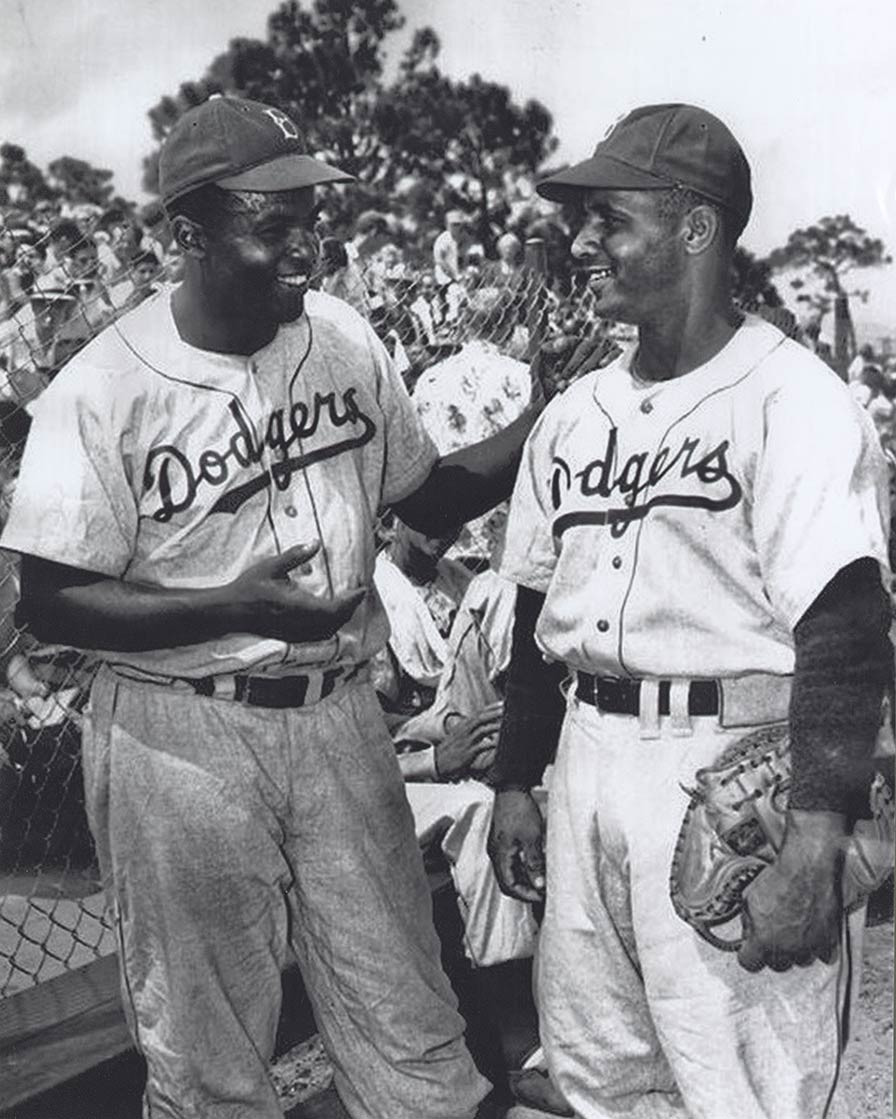
(L-R) Jackie Robinson; Roy Campanella. Jackie Robinson offers a congratulatory handshake to catcher Roy Campanella, March 31, 1948. The Brooklyn Dodgers have acquired Campanella from their Montreal AAA minor league team to add him to the Dodgers’ major league roster. On this date, the game is the first to be played by the Brooklyn Dodgers in Vero Beach at Dodgertown, the first racially integrated Spring Training camp in the South.
That event was when Dodgertown played a momentous role in furthering civil rights in the United States. Yes, 21 years before the Vero Beach schools were integrated, before Brown vs. Board of Education, before Martin Luther King Jr. led a movement, and before Rosa Parks’ activism.
On April 15, 1947, Robinson had made his historic debut for the Dodgers becoming the first Black to play in Major League Baseball the previous season. He still endured racism. But, in 1948 Florida where Jim Crow laws were very much in effect, playing and staying at Dodgertown meant that the Dodgers were MLB’s first fully-integrated spring training site in the South. Dodger President Branch Rickey had purposely moved the Dodgers out of the country for spring training camps in 1947 (Havana, Cuba) and 1948 (Ciudad Trujillo, Dominican Republic) since Robinson had encountered racial prejudice and was not welcome in Sanford, Florida as a minor leaguer in 1946.
When Rickey and the Dodgers were approached by prominent business leader Bud Holman about a spacious abandoned World War II U.S. Naval Air Station with its on-site barracks in Vero Beach, the land was the perfect solution to what Rickey desired for a “baseball campus” involving hundreds of players. In 1948, Dodgertown was inaugurated with nearly 600 minor league players while the major league Dodgers and Montreal Royals spent the bulk of the spring in the Dominican before arriving in Vero Beach for games on March 31 and April 1. Curiosity was abuzz from the local townspeople and nearby Black community of Gifford and Ft. Pierce to see Robinson – maybe some to jeer and more to cheer.
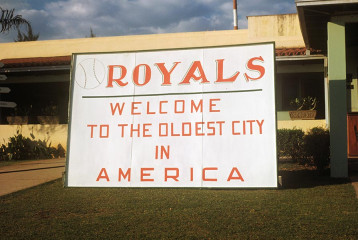
A sign welcoming the Montreal Royals, the Brooklyn Dodgers’ AAA team of the International League, to Ciudad Trujillo (also known as Santo Domingo), Dominican Republic for spring training, 1948. The Royals played the Dodgers at Dodgertown, Vero Beach, Florida in two exhibition games (March 31 and April 1) to continue the spring activities.
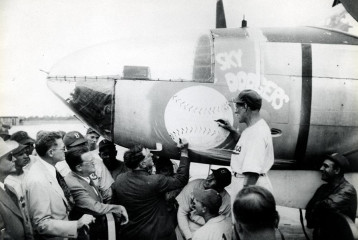
On March 31, 1948, four A-26 planes of the Brooklyn Air National Guard arrived on a direct flight from Brooklyn to Vero Beach Airport to help welcome the Dodgers and their return from the bulk of spring training in the Dominican Republic. Dodger Manager Leo Durocher is signing a large baseball on the side of the plane named “Sky Dodgers”. In a light suit in the front row second from left is Florida Governor Millard Caldwell, then; (L-R) Dodger Vice President and General Counsel Walter O’Malley, and Dodger President Branch Rickey. Wearing number 1 is Dodger shortstop Pee Wee Reese and under Durocher is Dodger outfielder Pete Reiser.
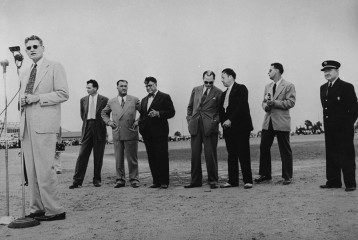
(L-R): Florida Governor Millard Caldwell addresses fans prior to throwing the first ball, March 31, 1948, Brooklyn vs. Montreal, the first Dodger game ever played at Dodgertown, Vero Beach, Florida. Sherman N. Smith, Attorney, Baseball Commissioner A.B. “Happy” Chandler, Dodger President Branch Rickey, Vero Beach Mayor Merrill Barber, Charles Mitchell, unidentified; and Admiral Edwin Peck who was the last commanding officer of the U.S. Naval Air Station during World War II in Vero Beach.
But, that was nothing new to Robinson, a lieutenant in the U.S. Army, who had refused to sit in the back of a military bus during his 1944 service at the segregated base in Ft. Hood, Texas and was court-martialed. At the conclusion of the trial, he was acquitted. He also was told by Rickey that he could not fight back on the field as a Dodger for two years, thus his 1947 season was filled with brutal obstacles – death threats, players intentionally spiking him with their cleats, and racists taunts from fans as well as the opposing team’s dugouts, among others.
Robinson persevered and was determined to let his on the field actions do the talking. He was named 1947 Rookie of the Year when only one for both leagues was selected. Campanella was a fine catcher and had played in the Negro Leagues prior to stints with Dodger minor league teams in Nashua, New Hampshire and Montreal. He was deemed a rising star in the organization. The Dodgers activated Campanella to the major league roster just prior to the March 31 game and he saw action coming in as a replacement for starter Gil Hodges.
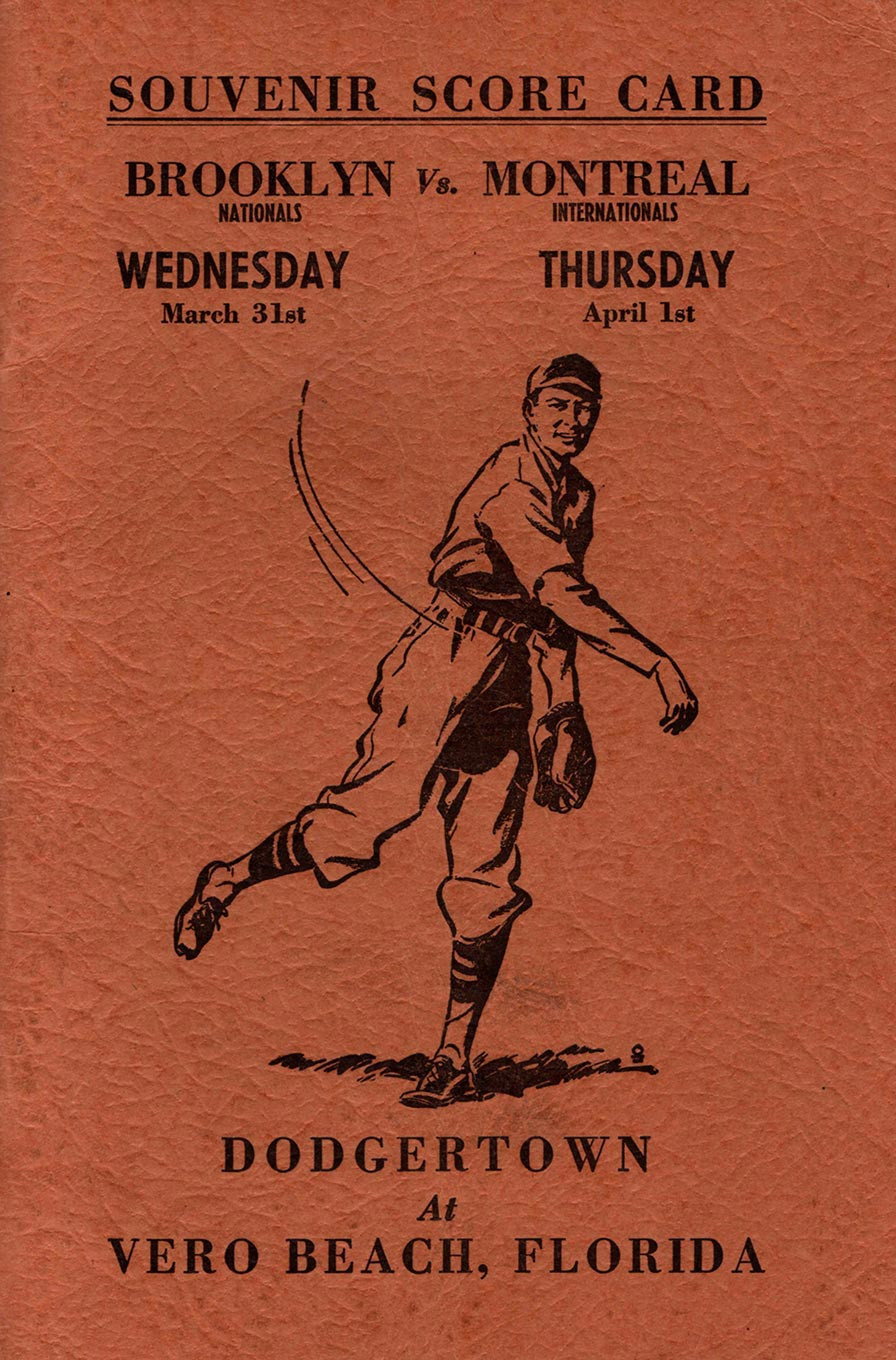
Front cover of the first Dodgertown, Vero Beach, Florida program, which was printed for two games between the Dodgers vs. Montreal Royals, Wednesday, March 31 and Thursday, April 1, 1948.
The first game was held at what was dubbed “Ebbets Field No. 2”, a field located near the Vero Beach Airport, across the road from the current complex. Press reports indicate that about 6,000 fans were in attendance, nearly 1,000 of them Black fans who were segregated and sat behind the left field area and towards center field. The population in Vero was only about 5,000 at the time.
Friends of Jackie Robinson, who made history playing in his first Dodger game at Dodgertown, Vero Beach, Florida, took out an ad in the program to salute the first baseman who had been named 1947 Rookie of the Year.
Robinson didn’t disappoint. As the lead-off hitter in the bottom of the first inning, he hit a home run to left field delighting his fans. The Dodgers beat Montreal, 5-4. Playing in the game were six future Baseball Hall of Famers: Pee Wee Reese, Arky Vaughan, Duke Snider, Gil Hodges, Jackie Robinson and Roy Campanella. Additional future Hall of Famers in attendance were Branch Rickey, Walter O’Malley, who was Rickey’s ownership partner and Dodger Vice President and General Counsel, Baseball Commissioner A.B. “Happy“ Chandler, Dodger Manager Leo Durocher who was with his wife, film star Laraine Day, and Dodger scout and coach George Sisler. Dodger broadcasters Red Barber and Ernie Harwell, later winners of the Hall of Fame’s Ford C. Frick Award, were with the team in 1948.
Other Black players were at Dodgertown that day, including pitcher Don Newcombe who made his Dodger debut in 1949 and Dan Bankhead, who played for the Dodgers in 1947 and returned to pitch for them in 1950-1951.
The Vero Beach Press Journal included this description of the game: “Wednesday was probably the biggest day in the history of Vero Beach, in more ways than one. Approximately 6,000 baseball fans and interested spectators witnessed the dedication ceremonies and ball game, the largest crowd ever to assemble for any event in this city.” But, what was not mentioned in newspapers is the social impact of that game which looms large 75 years later.
Dodgertown served as the spring training home of the Dodgers for 60 seasons, before it transitioned to Historic Dodgertown under the leadership of Peter O’Malley, President, Los Angeles Dodgers, 1970-1998 and Chairman, Historic Dodgertown, 2012-2018. In 1962, as Director of Dodgertown, O’Malley integrated Dodgertown’s Holman Stadium. Now, the site is the MLB-operated Jackie Robinson Training Complex which is developing a diverse collection of talented young men and women for baseball and softball’s new generation.
As time passes, the importance of the site, expanded, developed and maintained under the leadership of the O’Malley family for 58 years, has become more known for its place in history. In 2019, Historic Dodgertown was named to the U.S. Civil Rights Trail, the only sports site on the Trail, and was honored as a Florida Heritage Landmark in 2014 for its inclusion efforts, becoming MLB’s first fully-integrated spring training camp.
What Others Said About Integration At Dodgertown, Vero Beach, Florida:
Sam Lacy, columnist for the Baltimore Afro-American writes on March 4, 1961, “For 15 years, the Dodgers — colored and white — have lived together, eaten together, played cards and tennis and golf together and for 15 years, the other clubs have gone along living in the shadow of a dying ideology, ears cocked apprehensively for the noises they knew would some day be coming from the closet.” In 1974, Lacy writes of Dodgertown again in the Baltimore Afro-American, “All-for-one residence at the same time (for players)…it was, without doubt, the first crack in the wall of prejudice (Florida spring training segregation) that continued to plague baseball for the next 15 years (1948-1963).”
An Associated Press article in the Sarasota Herald-Tribune, Florida newspaper on March 18, 1962 reports of the rapid increase of major league clubs having equal living quarters for their organizational players and notes, “The Los Angeles Dodgers, pioneers of racial integration, have been living under one roof since 1948, one year after Jackie Robinson broke the color barrier…The Dodgers overcame the racial problem by purchasing an air base in Vero Beach, which houses all Dodger personnel…”. The article reports that seven of the 14 major league teams had now integrated their spring training residences since 1961, leaving six teams in Florida still with segregated camps.
Columnist Melvin Durslag writes on April 11, 1962 in the Los Angeles Herald Examiner, “Unlike a high majority of Florida baseball parks in Spring Training, Holman Stadium in Dodgertown is integrated for all fans. In town, O’Malley’s popularity hasn’t thickened.“
Brad Pye, sports editor of the Los Angeles Sentinel, writes of Dodgertown on March 20, 1980, “The Dodgers’ Spring Training operation here at Dodgertown in Vero Beach has to be the utopia of major league Spring Training camp. It’s strictly major league in training facilities, lodging accommodations, press facilities, food and the works….Over the years this facility, which was purchased primarily to shelter Jackie (Robinson), Roy (Campanella), Don (Newcombe), Jim (Gilliam), and the other Black ballplayers from the pains of prejudice, segregation, and bigotry, has seen many changes….In retrospect, a move which was originally made so that Black ballplayers could eat, practice and live with their teammates without any racial strife, has benefitted all the players who train here. It has also made the Dodgers the envy of the other pro sports teams.”
Charles Fountain, author of the 2009 book, “Under the March Sun: The Story of Spring Training,” writes of Dodgertown that “For the time being at least, Vero Beach retains Spring Training’s old-time intimacy like no place else. History was made here. And not just baseball history. Branch Rickey brought Spring Training to this abandoned naval air station in 1948 because the old barracks would be under the control of the Brooklyn Dodgers and thus free of the local segregation ordinances that blocked the mingling of the races in hotels and restaurants throughout Florida until the 1960s. At Dodgertown, the Dodgers could be a team on and off the field. How much of the integrated team’s considerable on-field success during the 1950s may have been born of that.”
— Researched and edited by Robert Schweppe

